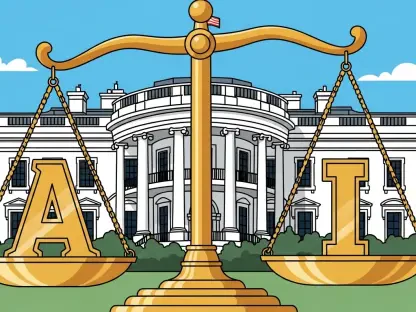Setting the Stage: A Pivotal Moment for Ethereum DeFi
Imagine a financial ecosystem where billions of dollars in value are locked in decentralized protocols, offering unprecedented opportunities for yield generation, yet teetering on the edge of regulatory scrutiny. This is the current reality for Ethereum’s decentralized finance (DeFi) sector, particularly with liquid staking mechanisms at the forefront. The U.S. Securities and Exchange Commission (SEC) has recently signaled that these innovative tools, which allow users to stake tokens while maintaining liquidity, might fall under federal securities laws. This development poses a critical question: how will this regulatory pivot influence Ethereum’s position as a DeFi powerhouse?
The purpose of this market analysis is to dissect the SEC’s evolving stance and its implications for Ethereum’s DeFi landscape. By examining current trends, market data, and potential future scenarios, this exploration aims to provide clarity for investors, developers, and stakeholders navigating this complex terrain. The stakes are high, as regulatory clarity could either propel Ethereum DeFi into mainstream adoption or push innovation to more lenient jurisdictions.
This analysis will delve into the nuances of the regulatory shift, assess its impact on market dynamics, and project how these changes might shape Ethereum’s competitive edge. With billions in total value locked (TVL) and a global race for crypto dominance, understanding these developments is essential for anyone invested in the blockchain space.
Diving Deep: Market Trends and Regulatory Impacts on Ethereum DeFi
Regulatory Waves: Unpacking the SEC’s New Approach
The SEC’s recent indication that liquid staking within the Ethereum ecosystem could be classified under securities laws marks a significant turning point for DeFi markets. Liquid staking, a mechanism enabling Ethereum holders to earn rewards while retaining asset liquidity through derivatives, underpins much of DeFi’s yield generation and asset management strategies. With billions in TVL tied to these protocols, the agency’s move to potentially regulate them as investment contracts introduces a layer of complexity that could redefine operational boundaries.
Unlike prior enforcement-focused tactics, the SEC now appears to prioritize collaboration with industry stakeholders, including protocol developers. This shift suggests a willingness to craft compliance pathways that balance investor protection with the need for technological advancement. If successful, this approach could stabilize market sentiment by reducing the uncertainty that has long plagued DeFi projects, potentially attracting more institutional capital into Ethereum-based platforms.
However, the specifics of this regulatory framework remain unclear, creating a dichotomy of outcomes. A stringent application of securities laws might impose burdensome compliance costs, limiting smaller protocols’ ability to compete. On the other hand, a nuanced policy could legitimize liquid staking in the eyes of traditional finance, fostering greater integration with broader markets. The direction taken will significantly influence Ethereum’s DeFi growth trajectory over the coming years.
Market Metrics: Ethereum’s Resilience Amid Uncertainty
Current market data reflects a robust yet cautious optimism within the Ethereum ecosystem despite regulatory headwinds. As of early August, Ethereum’s price hovers at $3,663, signaling sustained investor confidence even as the SEC’s stance unfolds. Comparatively, Bitcoin’s valuation at $115,732 demonstrates the broader digital asset market’s strength, yet Ethereum’s heavy reliance on DeFi makes it uniquely vulnerable to policy shifts. Liquid staking protocols alone account for a substantial portion of Ethereum’s TVL, underscoring their importance to the network’s economic activity.
The potential for regulatory clarity to drive adoption is evident in emerging trends such as the rise of cross-chain staking solutions and advanced yield optimization tools. If the SEC provides a flexible framework, analysts anticipate a surge in TVL and user engagement, as risk-averse institutional players may feel safer entering the space. Conversely, overly restrictive measures could dampen this momentum, diverting capital and talent to regions with more favorable policies, such as the European Union or Singapore, where crypto frameworks are already advancing.
Another factor to consider is market fragmentation. Should regulatory ambiguity persist, developers might prioritize offshore jurisdictions, leading to a splintered DeFi landscape. This risk is compounded by competitive pressures from alternative blockchains like Solana and Binance Smart Chain, which are vying for DeFi dominance. Ethereum’s ability to maintain its market share will hinge on how effectively the U.S. balances oversight with innovation in the immediate future.
Global Competitive Landscape: U.S. Policy in Context
Zooming out to the international stage, the SEC’s approach must be evaluated against a backdrop of accelerating global crypto regulation. Numerous jurisdictions are finalizing policies for stablecoins and digital assets, creating a race to establish competitive environments for blockchain innovation. The agency’s recent engagement with DeFi stakeholders indicates an awareness of these dynamics, with an apparent intent to align U.S. policies with global trends rather than isolate domestic markets.
For Ethereum’s DeFi sector, a harmonized regulatory environment could facilitate cross-border collaboration, enhancing the network’s appeal to international developers and investors. However, failure to keep pace with global standards risks positioning the U.S. as a less attractive hub, potentially driving talent and resources elsewhere. The concept of regulatory arbitrage—where projects exploit discrepancies between regional policies—also looms as a threat to market stability if not addressed through coordinated efforts.
Lesser-discussed implications include the impact on smaller DeFi protocols that lack the resources to navigate complex international compliance. These entities might struggle under a rigid U.S. framework, ceding ground to larger players or moving operations abroad. The SEC faces the challenge of crafting policies that not only protect investors but also ensure Ethereum DeFi remains a viable contender in the global arena, reflecting the interconnected nature of blockchain ecosystems.
Future Projections: Scenarios for Ethereum DeFi Under SEC Oversight
Looking ahead, several plausible scenarios emerge for Ethereum’s DeFi future based on the SEC’s regulatory direction. In an optimistic projection, a collaborative framework could unlock significant institutional adoption by providing clear guidelines for liquid staking compliance. This might catalyze a wave of capital inflows, boosting TVL and spurring innovations like enhanced staking derivatives and interoperable protocols, solidifying Ethereum’s leadership in DeFi from 2025 to 2027.
A more cautious outlook suggests that overly stringent policies could hinder growth, imposing operational constraints that limit protocol flexibility. Under this scenario, market participants might witness a slowdown in Ethereum’s DeFi expansion, with competing blockchains gaining traction as developers seek less restrictive environments. The potential for capital flight to offshore markets remains a tangible concern, particularly if regulatory ambiguity persists beyond the current year.
Technological advancements will also play a pivotal role in shaping outcomes. If Ethereum continues to innovate with scalable solutions and user-friendly tools, it could mitigate some regulatory pressures by maintaining user loyalty and market relevance. However, economic factors such as fluctuating crypto valuations and global financial conditions could amplify or dampen the impact of SEC policies. The interplay between these elements will likely define Ethereum’s DeFi trajectory in the near term, with regulatory clarity serving as the linchpin for sustained growth or potential setbacks.
Reflecting on the Analysis: Strategic Insights for Stakeholders
Looking back on this market analysis, the examination of the SEC’s regulatory shift revealed a landscape filled with both opportunity and uncertainty for Ethereum’s DeFi sector. The collaborative tone adopted by the agency offered a glimmer of hope for balanced oversight, while market data underscored Ethereum’s resilience amid looming policy changes. Projections highlighted a spectrum of outcomes, from mainstream adoption fueled by clarity to potential stagnation under restrictive rules, painting a complex picture of the road ahead.
Global competitive pressures emerged as a critical factor, reminding stakeholders of the urgency for the U.S. to act decisively to retain its position as a crypto innovation hub. The risk of market fragmentation and the challenges faced by smaller protocols added depth to the discussion, illustrating the broader implications of regulatory decisions. These findings collectively emphasized that the SEC’s forthcoming guidance would serve as a defining force for Ethereum’s market standing.
Moving forward, strategic actions for stakeholders became clear: developers and platforms should actively engage with regulators to shape practical compliance frameworks, prioritizing transparency in liquid staking operations. Investors, in turn, would benefit from diversifying holdings to hedge against policy risks while staying informed on SEC updates. For the industry at large, fostering dialogue through forums and advocacy groups could ensure that innovation and oversight coexist, paving the way for Ethereum DeFi to thrive in an evolving regulatory environment.









